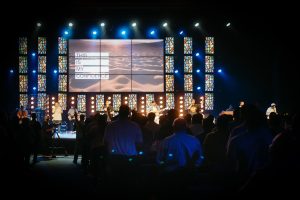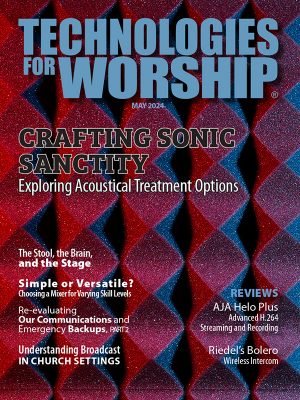
by Thomas Oliver
In many house of worship audio systems, the line array is the star of the show. Concert-style speaker systems are often a prominent aesthetic feature of contemporary sanctuaries, and the clarity and directional sound of a line array add undeniable power to live music performances and high-energy services. In many ways though, a line array is like a virtuosic lead guitarist – it adds something really special, maybe even irreplaceable, to the mix, but you don’t want it wailing away all the time.
By contrast, a 70V audio system is like the rhythm section: foundational, versatile, and even. On its own, a 70V system can affordably and discretely improve service accessibility and expand the functionality of your worship spaces. 70V systems are imminently flexible, allowing you to create managed zones throughout your facility or campus. They’re also easy to scale over time if you don’t have budget to extend sound reinforcement to every space at once. To truly torture my metaphor, you can start out with just a rhythm guitarist, and easily hire on a drummer and a bassist when the band hits it big. In combination with a line array system, a 70V system allows you to cater appropriately to the dynamics of each moment in a worship service, balancing clear, powerful music with introspective or subdued sermons and prayers.
In this article, I’m putting 70V audio in the spotlight, exploring considerations and best practices for a great foundational system.
Speaker Placement and Aesthetics
Though some churches choose to foreground technology, many congregations prefer a more traditional aesthetic. In this case, choosing 70V speakers that can effectively “disappear” into the design of the space is important. This means selecting speakers with color-matched finishes, or even just smaller, more unobtrusive equipment. Balancing frequency response requirements with a design preference for smaller speakers can be challenging: Small cones struggle to direct lower frequencies adequately, which can be a big problem in spaces with high ceilings. However, sometime when physics closes a door, it opens a window. A properly designed speaker enclosure can help direct the low-frequency sound energy that would normally propagate out of the back and sides of a 4” architectural speaker through the front instead, allowing it to produce rich sound that rivals a larger infinite baffle speaker.
If your concern is less about whether the speakers will be visible and more about the size of the holes you might need to drill into a 200-year-old coffered granite ceiling, you can also consider pendant speakers. Many high-quality architectural speakers can be neatly installed in a pendant enclosure, allowing you to deliver even coverage without damaging the architectural integrity of the space. As an added bonus, in sanctuaries with high ceilings, pendant speakers bring the audio source closer to the listener position, allowing you to achieve more even coverage with less power.
Designing for Coverage and Clarity
For any 70V system, intelligibility is job number one. No matter where congregants are seated in the sanctuary, they should be able to hear and understand every single word of the service. This is an area where 70V systems have a significant edge over line arrays: the directional nature of a line array creates “best listener positions,” which implies the existence of “worst listener positions.” They are also designed to draw listeners’ attention to a physical focal point, the “point source” of the sound – but sometimes, the goal is to direct attention inward. In this case, you want the sound to be omnipresent.
To get the maximum flexibility and functionality out of a 70V audio system in a house of worship setting, you should aim for audio coverage uniformity in the listener areas – that is, no more than an 6dB drop-off in the frequency range of the human voice from any one listener position to any other. You’re designing for every pew to be the best seat in the house, which requires laying out speakers with overlapping coverage patterns and rigorously testing. The AVIXA Audio Coverage Uniformity standard, last updated in 2022, has excellent guidance for setting coverage uniformity goals and verifying results. Adherence to these best practices is the gold standard for 70V audio system design in houses of worship.
 Tuning the System to the Space
Tuning the System to the Space
No matter how neat your coverage design looks in EASE, the real-world characteristics of the built environment are going to play a massive role in its actual performance. Every room has its unique acoustic characteristics, and with their mix of hard surfaces, natural materials, and lofty spaces, sanctuaries tend to have more than their share of acoustic foibles. Acoustic treatments can significantly enhance sound quality by controlling reflections, reverberations, and other unwanted acoustic phenomena. Proper placement of acoustic panels, bass traps, and diffusers can help in creating a more controlled acoustic environment.
You can also adjust the output of the system to better match the characteristics of the space. Using a Digital Signal Processer (DSP), you can adjust equalization, delay, and dynamics processing to ensure the best possible sound quality. This technology helps in addressing any acoustic challenges and optimizing the audio performance – and today, many commercial amplifiers come with a built-in DSP, allowing you to take advantage of a DSP’s benefits without incurring extra cost or devoting extra rack space.
Powering the System Appropriately
Speaking of amplifiers: selecting the right amp is key to powering a 70V system effectively. The amplifier should match the power requirements of the speaker system without underpowering or overpowering them. One of key strengths of a 70V system is scalability, however. When selecting an amp, it’s important to consider not just how big the system is now, but how big it’s likely to get. Amps are a key long-term investment: look for multi-channel equipment with a generous warranty and the capacity to handle your future needs.
Flexibility and Control
Different areas of a worship facility might have varying audio needs. For instance, the main hall, cry room, foyer, and outdoor areas might all require separate volume controls. Designing a system with managed zones allows for individual control over each area, ensuring that the audio levels are appropriate for the activities taking place in those spaces.
For most modern systems, you’ll also want a digital/analog interface for streaming, broadcasting, and recording. Integrating your 70V system with these technologies ensures that the high-quality audio experience extends to online viewers and listeners. This integration requires thoughtful planning: look for an interface with enough inputs and outputs to handle your use case, high-quality preamps, and ultra-low latency.
With multiple zones, live streaming /recording capabilities, and DSP-based room tuning, 70V audio system control can get pretty complex. It’s essential therefore, to prioritize ease of use in daily operations. Volunteers and staff operating the system should be able to manage it without extensive technical knowledge – which often requires precise expertise in design and setup. You need DSP, zoning, and recording presets your volunteer staff can initiate with a single action, reducing the risk of errors during services. I personally favor programmable buttons linked to clearly labelled presets for each part of the service – a volunteer of any age or technical ability can confidently help run sound with a setup like that.
A 70V audio system provides a versatile and scalable solution, ensuring consistent audio coverage and clarity. By carefully considering design, placement, power, tuning, zone control, integration, and ease of use, you can create an audio environment that enhances the worship experience and scales alongside your needs and means. Whether used alone or in conjunction with a line array system, a 70V setup can create engaging, accessible audio experiences for your congregation, fostering a deeper connection and enhancing your ability to reach congregants wherever they are.
Thomas Oliver has been a steadfast presence in the audiovisual industry since 1986. Over a ten-year span at LegrandAV, Tom undertook various positions including Regional Sales Manager, Key Account Manager, and finally, Director of Sales. As Director, he managed a team of seven Territory Managers and twelve Independent Rep Agencies. His tenure was marked by establishing strong connections with major distributor partners and dealers across the residential and commercial AV industries. As the Director of Commercial AV for Vanco International, Tom brings a wealth of knowledge and a network of valuable relationships to the table. Outside of work, Tom relishes attending sporting events and concerts with his wife near their home in St. Charles, IL.






